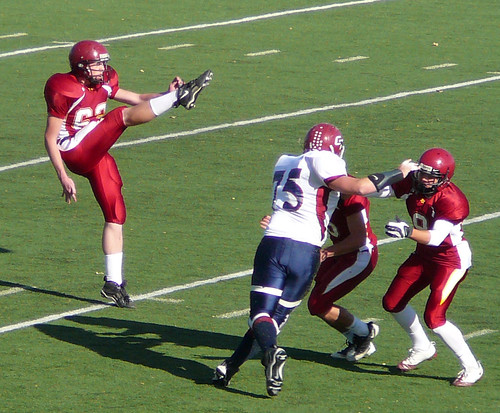It’s hard to believe that we’re already more than 20% done with the first summer session offering of DS106. It’s been four days of intense activity and technical snafus.
The technical issues have, at once, been the most frustrating aspect of the week — while also providing the most important “object lessons,” I think, so far.
Last semester, on a more traditional schedule, these kinds of issues could be addressed more methodically, over the course of several days. A student (or I) might have been frustrated by them for a day or two, but, invariably, we ironed them out and moved on without much discussion, delay, or drama.
This go around, when technical issues arise, we need to try and address them immediately. When you’re on a five-week schedule, you can afford to waste 2-3 days for anything. For this course, during this first week the most important task at hand has been getting students set up with their sites. This isn’t a small task — they must purchase a domain name and Web hosting space (terms and ideas which are usually incredibly foreign, in and of themselves). Then, they must edit their nameserver information appropriately. Since DNS propagation can take up to 48 hours, we can’t waste time getting this done. And because it can take up to 48 hours, it’s often more than a day before you discover if the site isn’t available because of a real issue.
In several cases in this class, sites never became available because of a problem with the registration with the host. At the point when we realized this, we were three days into the class. I asked the students if they wanted to wait another day (to see if we could iron out the problems with the host), or “punt” and just start up a blog on UMW Blogs to use for the class.
I was pretty conflicted about this choice — building their own site on a domain of their own is a core, foundational component of DS106! But, when you’re more than half-way through the first week and half your class can’t even post a blog post about digital storytelling, it’s time to regroup. In the end, they decided to start up on UMW Blogs. Not surprisingly, by the time class was over and I got back to my office, the technical issues had been resolved and the option of self-hosting was available again.. Several students decided, at that point, to make a go of installing WordPress on their Web space and, basically, starting over from scratch.
In addition to this headache, we’ve been struggling with getting a number of plugins to work properly. I’m not too upset about this issue. I want DS106 students to realize that configuring and managing a site is complicated, but that answers to problems can be found. And, most importantly, I want them to believe that they may be able to actually find those answers on their own. As I told them today, I could give them step-by-step instructions for how to install and configure specific plugins. But, what would be the point? Tomorrow, those steps could be different. And, depending, on slight nuances of how/where they have WordPress installed (what other plugins they’re using, what theme they’ve chosen), the steps might not even work. They would have learned nothing useful in terms of solving problems with technology. So, instead, I asked them to struggle with me as we worked through finding answers. It was pretty impressive to see them buckle down and try one Flickr and Twitter plugin after another until they hit on the magic one.
At one point, one student sort of asked me if they were going to be graded on whether they could get a Flickr plugin to display images in the sidebar. Of course, I said no. But it’s a telling question — and I hope my answer is telling as well. The point, for me, isn’t that displaying Flickr images in your sidebar represents some kind of holy grail (although it is pretty cool and I’d like them to be able to do it). The larger and more important point is that they grappled with the technology in ways that they might think were beyond them.
The final blow came this evening, when I discovered that the main ds106.us site has been taken down for behaving badly. I deeply fear that I caused this by activating multi-site over the weekend. We haven’t made any other major changes to the site, and there’s really no reason to think that traffic would be bringing things down. I don’t know the details of what’s going on yet, but I decided I needed to prepare for the worst. So, I spent tonight exporting my course site off of the multisite installation at ds106.us and importing it into a single WordPress install on my own, personal host. This was a pretty interesting exercise, moving a site from multisite to a single install raises some interesting challenges (particularly when you’re doing it by exporting/importing database tables).
At the last minute it occurred to me that I need to make the assignment repository available for my students, and since I’m not sure how long ds106.us will be down (and my students are starting to work on assignments out of it this weekend!), I needed to come up with a solution.
In the end, I decided to be ambitious and basically replicate the presentation of the assignments on my own site. This meant porting over the necessary templates and importing the RSS feed from the Google spreadsheet where the assignments are initially stored. In doing so, it occurred to me that I should make available links to this data source. I tweeted them, but for anyone who is interested (and missed the tweet) here they are:
- View the DS106 assignment spreadsheet
- Grab an RSS feed of the DS106 assignment spreadsheet
- Grab a (dynamic) CSV file of the DS106 assignment spreadsheet
The first one is particularly useful if the main DS106 site goes down. The second I’m putting out there in case anyone wants to use the data for their own nefarious means.
I’m still working on getting things all tied together on my ported site. I’m not sure if it will be the permanent house for my class or a temporary one while we figure out the hosting issues. I’ll probably try and set up a redirect from the old one to the new one for now.
Despite all of these various technical challenges, the class has been awesome (from my end) so far. By far the highlight of the week for me was a discussion on Tuesday about Gardner Campbell’s A Personal Cyber Infrastructure and Michael Wesch’s recent Faculty Academy presentation, From Knowledgeable to Knowledge-able. Both of them seemed to really resonate with the class. And, everytime I’ve started to get really frustrated with the various issues that have come up this week, I’ve reminded myself of Wesch’s call for vulnerability in the classroom. I’m definitely doing a good job of modeling constructive failure! It is funny how hard it is to remove your own ego and anxieties from the equation, however. While I talk about how I want my students to struggle and that failure is okay, I feel uncomfortable when I’m not modeling perfection (or something moderately close to it). As with so many other things in my life, I have to regularly remind myself to “let it (me) go.”
In other news, the vegetable garden is doing amazingly well considering the monsoon weather we’ve been having. Four days after putting it in, the plants are all thriving, and we already have seeds sprouting: sunflowers, beans, and broccoli. I’ve already gotten to have the experience of seeing my kids get home and run to the garden to see what’s new and what’s changed. Tonight, Madigan told me she couldn’t wait to come home and eat an afternoon snack right out of the garden.
[ Imagine a picture of my broccoli seedlings here. It is too dark and wet to take it now]
Hope springs eternal and gardens (both real and virtual) bloom all around us.





Add a comment